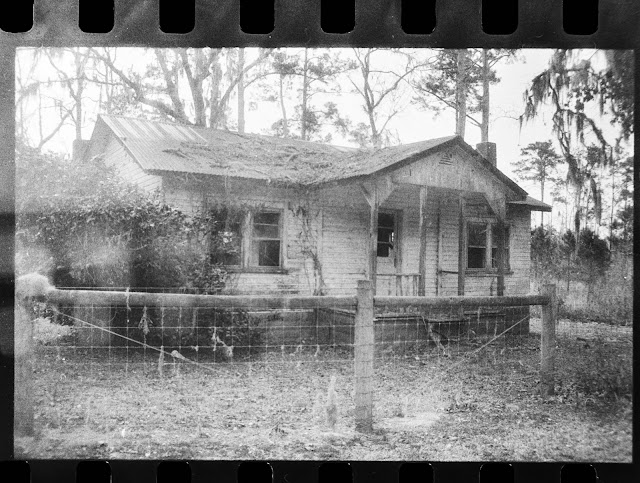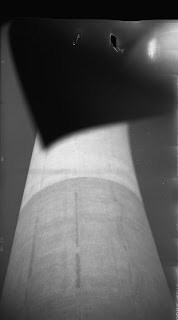The process of capturing an image is mechanically very simple. A shutter opens and allows the light reflected from a scene to hit a sensor that can translate that light into an image. Today's digital cameras us an electronic sensor, the previous generation of cameras use film and before that treated glass was the sensor, but in the end it is the exact same process.
The variables are the same today as they were in the first days of photography. The amount of light entering the camera is controlled by the size of the hole made by the shutter and by the length of time it remains open. The sensitivity to light of the sensor (be it film, glass or electronic) is the third variable. That's it, the Exposure Triangle, the interplay between time, hole size (called aperture) and sensitivity (measured in ISO today).
 |
| All the settings you’ll need |
My fancy new Canon EOS-R digital camera allows me to pick the ISO, or sensitivity of my sensor. Film cameras are limited to the sensitivity of the film selected, but there is a wide range even today when few companies are making film. That part of the triangle is no different with my Brownie than it is with the Vivitar I used in college. Shutter speed is pretty simple as well. The EOS-R can snap off a shot in 1/8000th of a second or keep the shutter open as long as I choose. Here is one big difference that technology has brought us. The Brownie has three entire shutter speeds- 1/25th, 1/50th and 1/100th of a second. It also has a B mode that leaves the shutter open as long as the shutter lever is held down and a T mode that opens it on one click and closes it on the next.
 |
| On the left here are the shutter speeds: 25, B, 50, T, and 100 |
Aperture is a function of the lens, so the smallest and largest openings vary with which lens I use for the EOS-R. The Brownie does not have an option to switch lenses, so the aperture range is fixed, in the case of this camera between f32 (the smallest hole) and f8 (the largest hole). One fun thing I've taken advance of is that on the Brownie the aperture selector is a simple lever that doesn't necessarily need to stop at one of the stops printed on the camera. Another fun thing is that Kodak before the 1930s didn't us f-stops to measure aperture, they used the US system, which is very close and looks like the f-stop numbers I'm used to seeing, but really isn't. I easily found a translator online and have pretty much memorized which is which already, so it isn't a huge problem, just a little quirk.
 |
| The apertures in the US system. To help out, Kodak has provided descriptions of the conditions under which one might use each setting. I love that there’s a “Marine” setting. |
The effect of these differences is to narrow options. I've heard people smarter than me say that the slowest shutter speed one can reliably hand hold and keep things in focus is 1/250th of second. So my 1/100th is a bit iffy even if my hands are unusually steady, and the other two slower speeds definitely require a tripod. One interesting thing that has NOT changed in 100 years is the thread size of tripod heads, so my modern tripod fits this old thing perfectly. But for normal, not lugging around a tripod, circumstances, it's 1/100th or nothing.
That leaves aperture as our only option to control exposure. I've used 400 ISO film, which is pretty much middle of the road, and on sunny days it's been right about f16 or f11, depending on shade. without a light meter on the camera, I'm left to use a photo app or the Sunny 16 Rule (which deserves its own post, I think). Theoretically I should have some fairly decently exposed images on the three rolls I've shot, but we shall see when they get developed.
Once you get the exposure correct, it's time to focus. I will admit to being spoiled by autofocus, but this lens doesn't really have a manual focus either. Focusing is accomplished by slight adjustments in the distance the bellows and lens assembly extend. There are marks for 8 feet, 25 feet and 100 feet. You just guess which one is closest to what you're looking at and pray I guess. Again, we shall see. The relatively small apertures will tend to give a larger depth of field (more of the scene will be in the same area of focus) so maybe it will work out ok.
 |
| Here’s the super-helpful focusing system. Just always be 8, 25 or 100 feet from whatever you’re shooting! |
The last big difference with this camera doesn't so much affect the process, but requires some work to overcome. The film type used in this camera, 116, hasn't been produced since the 1980s. It's a medium format film, and is not so far off from the 120 size used in today's medium format cameras. All I needed to do is buy some little 3D printed spacers to make the smaller 120 reels fit in the space meant to hold 116. It makes loading the film an adventure, though.
 |
| The spiffy spacers that make modern film fit in the 100 year old camera |
I've frankly loved shooting with this camera. The lack of options is actually kind of liberating. My first camera had a light meter, but it required batteries and I had no idea, so I didn't even know it was there. So I've had a good grasp of the exposure triangle and figuring out settings in my head for a while. It came back like riding a bike, thankfully. So without worrying too much about that, you only have to think about what you are shooting. It's fun and a great way to understand what is happening behind the scenes of modern cameras (or phones for that matter).
Of course all of this may become much more frustrating if the film gets developed and looks terrible. I can't wait.





























